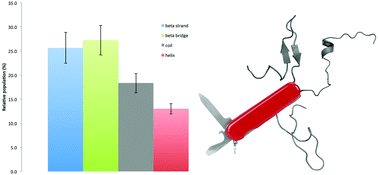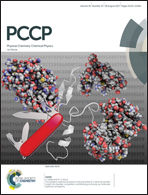The transient manifold structure of the p53 extreme C-terminal domain: insight into disorder, recognition, and binding promiscuity by molecular dynamics simulations†
Abstract
The p53 tumour suppressor is a transcription activator that signals for cell cycle arrest and apoptosis. In its active form p53 is a tetramer, with each monomer organised in domains with different degrees of structural stability, ranging from the well folded DNA-binding domain (DBD) and tetramerization domain (TET), to the intrinsically disordered transactivation domain (TAD), and extreme C-terminal domain (CTD). Compared to all other domains, the structure/function relationship of the p53-CTD within the full-length p53 tetramer is still poorly understood due to its high degree of conformational disorder. Meanwhile, the structure of p53-CTD-like peptides has been well characterized when in complex with a variety of receptors, where, as other intrinsically disordered regions (IDR), it adopts specific, while diverse, conformations. Receptor-specific folding is likely to occur upon binding, either from a random coil, or as a result of an initial recognition of a pre-formed structural motif, known as molecular recognition feature (MoRF), selected by the receptor within the conformational ensemble of the IDP in solution. In this latter case, MoRFs act as nucleation sites, favouring the initiation of the folding process within the binding site. In this work we show the results of over 20 μs of cumulative molecular dynamics (MD) simulations of a 22 residue peptide unbound in solution with sequence corresponding to the p53-CTD 367–388 section. Such extensive sampling allowed us to identify and characterize the structure of specific sets of minimal structural MoRFs within the p53-CTD peptide conformational ensemble at equilibrium. These motifs are short, involving only 3 to 4 residues, and specifically localized within the peptide sequence. Corresponding patterns of secondary structure propensity along the p53-CTD sequence are also predicted by disorder prediction calculations. Based on these findings we discuss how the structural complementarity of specific minimal structural MoRFs to the binding site of different receptors could regulate the p53-CTD binding promiscuity.



 Please wait while we load your content...
Please wait while we load your content...